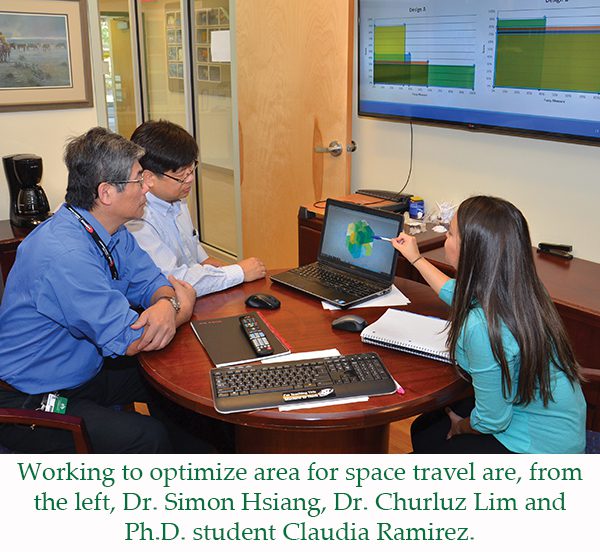Making the Most of Space in Space

Future space missions will reach greater distances and span longer durations. Design of spacecraft and habitats to better accommodate habitability functions will be more important than ever. To achieve this, mission planners and spacecraft designers now need tools to help them better define habitable volume and identify mission and programmatic risks. Volume directly drives mass and cost, so well-informed estimates early in the design process are key.
Consider a family of four will soon be on its way to Mars. The real estate agency that will provide living quarters for the four-year mission is NASA. The mother, father and children all have different demands for how the space within the spacecraft will be used. Mom wants a nice living area with windows, Dad wants a functional work space, and the kids want a large play area. Meeting these human-factor needs is as critical to the success of the mission as the safety and mechanical functions of the spacecraft. How to achieve this within the limited volume of the craft is the challenge for NASA.
This is one of many scenarios that Systems Engineering researchers within the Lee College of Engineering are working to optimize as part of the Computational Model for Spacecraft/Habitat Volume project. Sponsored by NASA’s Human Systems Integration Division, the project started in the spring of 2016 and is scheduled to run until 2018. The UNC Charlotte researchers are working with NASA colleagues at Johnson Space Center in Houston, Texas, and Glenn Research Center in Cleveland, Ohio.
“Once you put human beings into a space mission it becomes much more complex,” said Dr. Simon Hsiang, principle investigator on the project and chair of the Systems Engineering and Engineering Management Department. “You now have life support elements such as food, water and oxygen. But you also have human-factor needs, and there must be a balance between the psychophysical needs of diverse people in the spacecraft and the fundamental mechanical needs of the ship.”
 The UNC Charlotte team is using mathematical models to optimize the space considerations. With numerous scenarios for length of voyages, numbers of people and types of missions, there is a huge amount of data going into the models.
The UNC Charlotte team is using mathematical models to optimize the space considerations. With numerous scenarios for length of voyages, numbers of people and types of missions, there is a huge amount of data going into the models.
“One of the main considerations is the duration of the trip,” Dr. Hsiang said. “It’s similar to a car trip on earth. If you’re just driving across town you can be comfortable in a small Fiat, but if you’re crossing the country you need something much bigger. Another major factor is the number of people. Is the space needed for a family of four going to Mars or for 10 scientists living and working on a space station?”
Some sections of a spacecraft can have multiple uses at different times. An advantage of space travel is that in zero gravity there is no up or down, so space can be arranged in numerous ways.
“There are all kinds of considerations, and you have to realize you can’t make everybody happy,” Dr. Hsiang said. “There have to be trade-offs. Our task is to determine the best compromises.”
Claudia Ramirez, a Ph.D. student in the UNC Charlotte Infrastructure and Environmental Systems program is involved in collecting the data about human preferences and then weighing them against spacecraft performance considerations.
“We have to find out what is most important to the astronauts,” Ramirez said. “These are the psychophysical factors. We have to determine what the four to six most important factors are to various user groups.”
The NASA user groups who are ranking the importance of the multiple factors are Task Performance, Safety, Health and Well Being, and Subsystems Integration.
“We have them rank factors for primary and secondary importance,” Ramirez said. “We enter this data into our model, which determines the best use for different space modules. We then use MATLAB to build a 3D representation of the optimal spacecraft. It’s like trying to arrange LEGO blocks into the smallest volume possible, with each block in an optimal position.”
Research team member Dr. Churlzu Lim, an associate professor in Systems Engineering, is involved in building the mathematical optimization models for the project. “There are a lot of tasks that have to be accomplished in space travel such as eating, exercise, working and sleeping, and they all require space,” he said. “The data for these critical tasks are the building blocks we work with. Some can overlap and some can’t. Since the space in the craft is pricey, my goal is to find the best arrangement of blocks to minimize the total volume, which is a challenging mathematical optimization problem.”
Visualization charts from Dr. Lim’s model show the layout of building blocks, areas of overlap and orientations of human tasks performed in each block. Using the models, NASA can then estimate spacecraft volume needs for various missions, assess and create space layout based on volume and mitigate risk characteristics associated with volume.
“Compared to the research I’ve done in the past,” Dr. Lim said, “this project is very different. I really like working with NASA. For me it’s totally new, which makes it fun.”
For more information see https://lsda.jsc.nasa.gov/scripts/experiment/exper.aspx?exp_index=13619 .